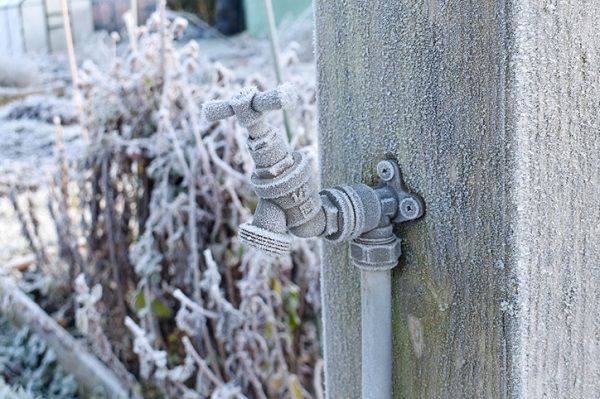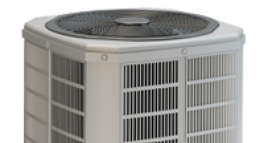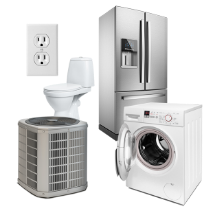Deicing around your home can increase safety, prevent injuries, and help reduce damage to important home items. It can also prevent big problems from becoming catastrophic. Use these tips to properly deice your walkway/driveway, car windshield, and hose bibs/frozen pipes.
Deicing Walkways/Driveways
There are a few good deicers for walkways and driveways. Any of the following will do the job, but some may come with unintended consequences.
1. Salt
Salt is the most common deicer you can use for your walkway and driveway. It’s inexpensive, mostly harmless (keep it away from grass or flower beds), and extremely easy to use.
Just toss a good portion of salt on your walkway or driveway, give it a few minutes, and shovel the ice melt away.
There are a couple downsides to salt. Over time, salt will degrade concrete, causing potholes, cracks, chipping, and staining.
Additionally, if it’s too cold—generally, below 15°F—salt will be less effective at melting ice.
2. Isopropyl alcohol mixture
Isopropyl alcohol (70% or 91%) has an extremely low freezing point and is relatively inexpensive, which makes it a good deicer. (And you might still have a bunch stocked up from the pandemic!)
A good way to use it is to mix about 2 tablespoons with a half-gallon of water and put it in a spray bottle or bucket. Then, apply it to ice patches, wait for it to melt, and shovel the ice melt away.
A big benefit of using isopropyl alcohol is that it won’t damage or stain concrete. It will also still work in extremely cold temperatures (the higher the alcohol content, the lower the freezing point).
However, if you have a long walkway or driveway, this method can be tedious.
3. Baking soda
Baking soda is a slightly weaker but totally harmless method of deicing walkways and driveways. It won’t damage your concrete and won’t harm any grass or plants.
However, it is slightly less effective than salt in terms of speed and strength. Additionally, like salt, once it gets extremely cold, it becomes less effective.
Deicing Car Windshields
Deicing car windshields is a little less labor intensive than deicing your walkway/driveway. Use these methods in addition to a sturdy ice scraper.
1. Use the defrost setting
Setting your car’s heating system to the defrost setting is the easiest way to deice your windshield.
However, there are two important things you should avoid when using the defrost setting.
First, never leave your car idling in an enclosed space like a garage without ventilation. This can cause carbon monoxide buildup, which can kill you. Additionally, make sure your car’s tailpipe isn’t blocked by snow or ice itself for the same reason.
Second, don’t leave an idling car unattended while it warms up/defrosts. It’s an easy way for someone to steal it.
2. Isopropyl alcohol mixture
Just like with walkways, an isopropyl alcohol/water mixture in a spray bottle can quickly deice your car’s windshield and make scraping it much easier.
Deicers to Avoid for Car Windshields
There are a couple of methods that you should never use for car windshields.
1. Pouring hot, boiling, or cold water
This is a terrible and dangerous idea. Pouring water of any temperature directly on a frozen windshield can crack your windshield. Additionally, boiling water can burn you if you aren’t careful.
2. Anything other than a dedicated ice scraper
Knives, credit cards, brooms, and other flat-edged items are more likely to scratch the windshield. In the worst cases, they can shatter your glass. And obviously, they simply aren’t as efficient.
Deicing Hose Bibs/Frozen Pipes
Before we go into deicing hose bibs and pipes, we suggest that you insulate them before they freeze.
For hose bibs, take the following steps.
- Remove any hoses and attachments. Drain them and store them for the winter.
- Turn off any shutoff valves attached to the bib.
- Open the bib to let any excess water drain.
- If an exterior bib doesn’t have a shutoff valve, insulate that bib with Styrofoam or other insulating material.
For exposed pipes, simply insulate them with Styrofoam or another insulating material.
For interior pipes, you should leave faucets dripping during extremely cold weather. For pipes underneath sinks, keep the cabinet doors open to allow warm air to reach them. Check out our full guide for how to keep pipes from freezing.
If you suspect that your hose bibs or pipes are already frozen, here are a few solutions. Typically, frozen bibs and pipes only allow a trickle of water when frozen, or no water flow at all.
1. Towels and hot water
If your bibs or pipes are obviously frozen (e.g., you can see ice on them), are only trickling, or aren’t allowing water flow at all, apply towels to the frozen area, if possible. Then, slowly saturate the towels with hot water.
Continue until water begins to flow. Then, check for leaks. If there are no leaks, insulate the bib or pipe. If there are leaks, call a licensed plumber.
2. Hair dryer
Simply apply heat to the affected pipe until water begins to flow normally. Then, check for leaks. If there are no leaks, insulate the bib or pipe. If there are leaks, call a licensed plumber.

2-10 Can Help You Protect More
Deicing is an important part of winter home maintenance and enjoying your home in the winter. Another important part of enjoying your home in the winter is having protection against unexpected breakdowns with a 2-10 Home Buyers Warranty (2-10) Home Warranty Service Plan.
A 2-10 Home Warranty Service Plan protects your budget against unexpected breakdowns to systems and appliances caused by routine use. It also gives you access to local, trusted contractors who can help you diagnose and solve breakdowns.









